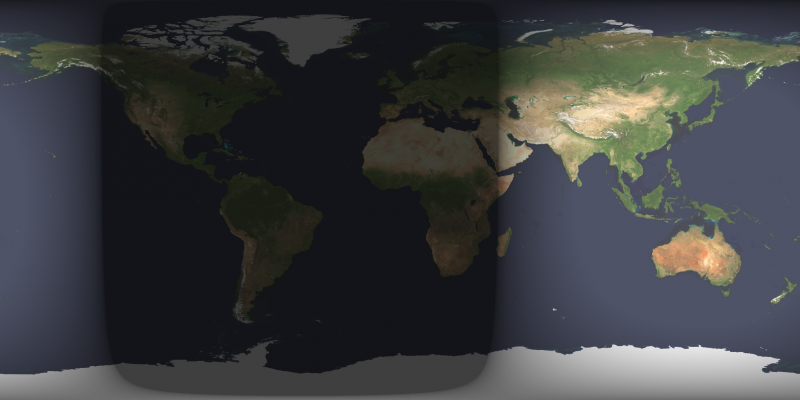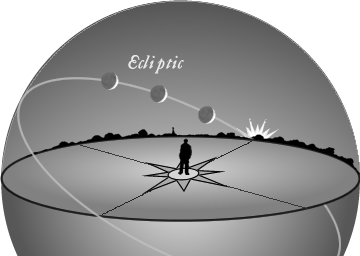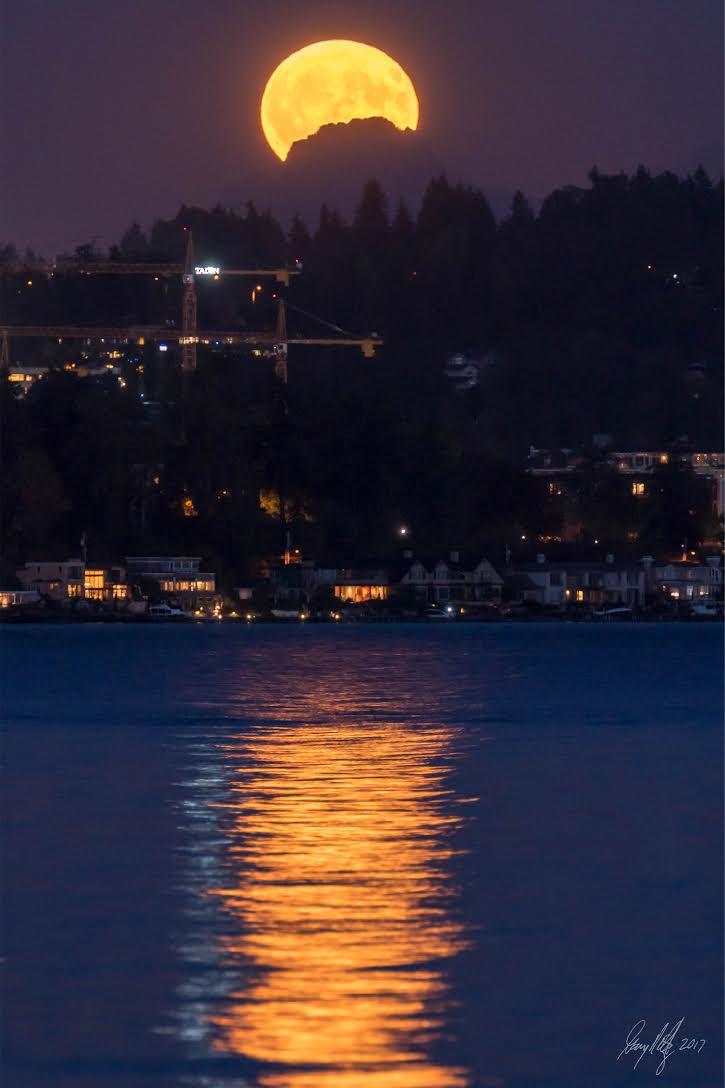
At top: 2017’s Harvest moon via our friend Steve Scanlon Photography in Holmdel, New Jersey..
Full moon falls on September 24, 2018 for us in the Americas, and on September 25 for much of the rest of the world (more about exact times below). It’s the first full moon of autumn for the Northern Hemisphere and first full moon of spring for the Southern Hemisphere. It’s the closest full moon to the September equinox. That makes it the Northern Hemisphere’s Harvest Moon!
No matter where you live worldwide, the moon will appear plenty full to you on both September 24 and 25, lighting up the night from dusk until dawn.
The exact time of full moon comes for all of us at same instant worldwide, but our clocks read differently by time zone.
The crest of the moon’s full phase is September 25, 2018, at 2:52 UTC; translate UTC to your time. For the mainland United States, that’s September 24 at 10:52 p.m. EDT, 9:52 p.m. CDT, 8:52 p.m. MDT, 7:52 p.m. PDT, 6:52 p.m. AKDT (Alaska Daylight Time), and 4:52 p.m. HST (Hawaiian Standard Time).

Worldwide map of the day and nights sides of Earth at the exact instant of the full moon (September 25, 2018 at 2:52 UTC) via the US Naval Observatory. The shadow line at left depicts sunset September 24. The shadow line at right depicts sunrise September 25.
At the vicinity of full moon, the moon stays more or less opposite the sun throughout the night. A full moon (or nearly full moon) rises in the east around sunset, climbs highest up for the night around midnight and sets in the west around sunrise.
In this respect, the full moon displays this same characteristic in both the Northern and Southern Hemispheres.
Yet this closest full moon to the September equinox displays special characteristics for both the Northern and Southern Hemisphere, related to the time of moonrise and the place of moonrise along your eastern horizon.

Greg Redfern caught a lunar corona around 2017’s full Harvest Moon.
On the average, the moon rises 50 minutes later each day. For us in the Northern Hemisphere, the lag time between each day’s moonrise is at a minimum for the year. From 40 degrees north (Denver, Colorado, or Philadelphia, Pennsylvania), the moon now rises some 30 (instead of 50) minutes later. From Anchorage, Alaska (just north of 60 degrees north latitude), the moon rises only 10 minutes later.
The higher the latitude, the greater the Harvest Moon effect – the effect of no great lag time between sunset and moonrise – in the season of waning daylight.
At southerly latitudes in the Southern Hemisphere, where it’s now spring, the effect is opposite. In spring, the moon rises more than 50 minutes later on evenings following the September full moon.
Want to know when the moon rises for the next several days in your part of the world? Click here and remember to check the moon phases and moonrise and moonset boxes.

In early autumn, at sunset, the angle of the ecliptic – the sun’s yearly path or the moon’s monthly path in front of the constellations of the zodiac – makes a narrow angle with the horizon. Image via classicalastronomy.com.
But we mentioned a second effect, along with the time of moonrise. It’s about the place of moonrise on your eastern horizon.
All full moons rise opposite the sun. That’s what makes a full moon look full. Close to the exact time of this September moonrise, from any part of the world, the moon rises approximately due east. On the next few nights after that – depending on where you are in the world – the place of moonrise varies.
From the Northern Hemisphere, you’ll find the moon rising farther and farther north along your eastern horizon each evening. Don’t know which way is north? No problem. As you stand facing eastward, north is your left. From the Southern Hemisphere, the variation in the place of moonrise along your eastern horizon – as viewed from one night to the next – won’t be nearly as great.
Check out the chart below.

The narrow angle of the ecliptic means the moon rises noticeably farther north on the horizon, from one night to the next. So, as viewed from northerly latitudes, there’s no long period of darkness between sunset and moonrise. Image via classicalastronomy.com.
By the way, six lunar months (full moons) from now – on March 21, 2019 – it’ll be the Southern Hemisphere’s turn to enjoy a full Harvest Moon. At that time, from around the world, the southbound moonrises following the March 2019 full moon will provide southerly latitudes with the short lag time between successive moonrises.
Can’t get enough of the Harvest Moon? Mike Cohea caught the video below … the October 5, 2017 Harvest Moon rising behind the Old Scituate Lighthouse in Scituate, Massachusetts.
MikeCohea_HarvestMoon_TL from Mike Cohea: Multimedia Producer on Vimeo.
Bottom line: From around the word on September 24 and 25, 2018 – enjoy dusk-until-dawn moonlight. It’s the Northern Hemisphere’s full Harvest Moon and the Southern Hemisphere’s first full moon of spring.
from EarthSky https://ift.tt/2NAS6yP

At top: 2017’s Harvest moon via our friend Steve Scanlon Photography in Holmdel, New Jersey..
Full moon falls on September 24, 2018 for us in the Americas, and on September 25 for much of the rest of the world (more about exact times below). It’s the first full moon of autumn for the Northern Hemisphere and first full moon of spring for the Southern Hemisphere. It’s the closest full moon to the September equinox. That makes it the Northern Hemisphere’s Harvest Moon!
No matter where you live worldwide, the moon will appear plenty full to you on both September 24 and 25, lighting up the night from dusk until dawn.
The exact time of full moon comes for all of us at same instant worldwide, but our clocks read differently by time zone.
The crest of the moon’s full phase is September 25, 2018, at 2:52 UTC; translate UTC to your time. For the mainland United States, that’s September 24 at 10:52 p.m. EDT, 9:52 p.m. CDT, 8:52 p.m. MDT, 7:52 p.m. PDT, 6:52 p.m. AKDT (Alaska Daylight Time), and 4:52 p.m. HST (Hawaiian Standard Time).

Worldwide map of the day and nights sides of Earth at the exact instant of the full moon (September 25, 2018 at 2:52 UTC) via the US Naval Observatory. The shadow line at left depicts sunset September 24. The shadow line at right depicts sunrise September 25.
At the vicinity of full moon, the moon stays more or less opposite the sun throughout the night. A full moon (or nearly full moon) rises in the east around sunset, climbs highest up for the night around midnight and sets in the west around sunrise.
In this respect, the full moon displays this same characteristic in both the Northern and Southern Hemispheres.
Yet this closest full moon to the September equinox displays special characteristics for both the Northern and Southern Hemisphere, related to the time of moonrise and the place of moonrise along your eastern horizon.

Greg Redfern caught a lunar corona around 2017’s full Harvest Moon.
On the average, the moon rises 50 minutes later each day. For us in the Northern Hemisphere, the lag time between each day’s moonrise is at a minimum for the year. From 40 degrees north (Denver, Colorado, or Philadelphia, Pennsylvania), the moon now rises some 30 (instead of 50) minutes later. From Anchorage, Alaska (just north of 60 degrees north latitude), the moon rises only 10 minutes later.
The higher the latitude, the greater the Harvest Moon effect – the effect of no great lag time between sunset and moonrise – in the season of waning daylight.
At southerly latitudes in the Southern Hemisphere, where it’s now spring, the effect is opposite. In spring, the moon rises more than 50 minutes later on evenings following the September full moon.
Want to know when the moon rises for the next several days in your part of the world? Click here and remember to check the moon phases and moonrise and moonset boxes.

In early autumn, at sunset, the angle of the ecliptic – the sun’s yearly path or the moon’s monthly path in front of the constellations of the zodiac – makes a narrow angle with the horizon. Image via classicalastronomy.com.
But we mentioned a second effect, along with the time of moonrise. It’s about the place of moonrise on your eastern horizon.
All full moons rise opposite the sun. That’s what makes a full moon look full. Close to the exact time of this September moonrise, from any part of the world, the moon rises approximately due east. On the next few nights after that – depending on where you are in the world – the place of moonrise varies.
From the Northern Hemisphere, you’ll find the moon rising farther and farther north along your eastern horizon each evening. Don’t know which way is north? No problem. As you stand facing eastward, north is your left. From the Southern Hemisphere, the variation in the place of moonrise along your eastern horizon – as viewed from one night to the next – won’t be nearly as great.
Check out the chart below.

The narrow angle of the ecliptic means the moon rises noticeably farther north on the horizon, from one night to the next. So, as viewed from northerly latitudes, there’s no long period of darkness between sunset and moonrise. Image via classicalastronomy.com.
By the way, six lunar months (full moons) from now – on March 21, 2019 – it’ll be the Southern Hemisphere’s turn to enjoy a full Harvest Moon. At that time, from around the world, the southbound moonrises following the March 2019 full moon will provide southerly latitudes with the short lag time between successive moonrises.
Can’t get enough of the Harvest Moon? Mike Cohea caught the video below … the October 5, 2017 Harvest Moon rising behind the Old Scituate Lighthouse in Scituate, Massachusetts.
MikeCohea_HarvestMoon_TL from Mike Cohea: Multimedia Producer on Vimeo.
Bottom line: From around the word on September 24 and 25, 2018 – enjoy dusk-until-dawn moonlight. It’s the Northern Hemisphere’s full Harvest Moon and the Southern Hemisphere’s first full moon of spring.
from EarthSky https://ift.tt/2NAS6yP


Aucun commentaire:
Enregistrer un commentaire